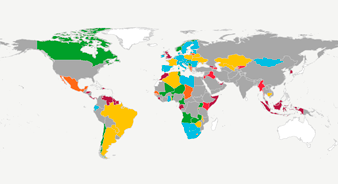Indicator 6.5.2 “Proportion of transboundary basin area with an operational arrangement for water cooperation”
Target 6.5 emphasizes the importance of transboundary cooperation – this page explains why and how to monitor progress towards the target.
The indicator at a glance
Indicator 6.5.2 tracks the percentage of transboundary basin area within a country that has an operational arrangement for water cooperation.
An arrangement for water cooperation is a bilateral or multilateral treaty, convention, agreement or other formal arrangement between riparian countries that provides a framework for cooperation.
For the arrangement to be considered operational, the following criteria need to be fulfilled:
- Existence of a joint body.
- Regular, formal communication between riparian countries (at least once a year).
- Joint or coordinated management plans or objectives.
- Regular exchange of data and information (at least once a year).
Data are commonly compiled by relevant national line ministries and institutions (e.g. for Water, Environment, Natural Resources, Hydrology, Geology).
Available support
The United Nations Economic Commission for Europe (UNECE) and the United Nations Educational, Scientific and Cultural Organization (UNESCO) are the custodians of indicator 6.5.2. For any enquiries about available support, please contact their helpdesk.
Guidance on data collection and reporting
- UNECE and UNESCO: Monitoring methodology.
- UNECE and UNESCO: Template for reporting.
- UNECE and UNESCO: Guidance on reporting.
- UNECE: General information including on Water Convention reporting.
- UNESCO: General information.
- UN-Water: Data collection process and timeline.
Online support
- UNECE and UNESCO: Helpdesk (email, phone, video conference).
- UNECE and UNESCO: Webinars (previous webinars: 2017, 2020 (including examples from Georgia, Ghana, Slovenia and Uganda) and 2023 (including examples from Austria, Hungary, North Macedonia and South Africa)).
Face-to-face support
- Regional workshops.
- Presentations at global intergovernmental meetings and sessions in various fora.
Data and progress reporting
- UN-Water: SDG 6 Data Portal.
- UNECE and UNESCO: National country reports.
- UNECE and UNESCO on behalf of UN-Water: 2018 Progress Report.
- UNECE and UNESCO on behalf of UN-Water: 2021 Progress Report (including infographics).
- UNECE and UNESCO on behalf of UN-Water: 2024 Progress Report.

Why monitor transboundary cooperation?
Monitoring of transboundary cooperation provides impetus for countries to assess the current status of cooperation with neighbouring countries, and set targets for improved coordination.
